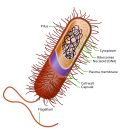Gram-negative bacteria are bacteria that, unlike gram-positive bacteria, do not retain the crystal violet stain used in the Gram staining method of bacterial...
27 KB (2,777 words) - 00:08, 11 June 2025
The Gram stain is used by microbiologists to place bacteria into two main categories, gram-positive (+) and gram-negative (−). Gram-positive bacteria have...
24 KB (2,652 words) - 13:18, 10 June 2025
and gram-negative bacteria. It may also be used to diagnose a fungal infection. The name comes from the Danish bacteriologist Hans Christian Gram, who...
27 KB (2,815 words) - 05:37, 11 July 2025
resistant Gram-negative bacteria (MDRGN bacteria) are a type of Gram-negative bacteria with resistance to multiple antibiotics. They can cause bacteria infections...
6 KB (721 words) - 06:18, 8 November 2023
Lipopolysaccharide (redirect from Gram negative shock)
for components of the outermost membrane of the cell envelope of gram-negative bacteria, such as E. coli and Salmonella with a common structural architecture...
63 KB (7,214 words) - 09:40, 17 July 2025
Bacterial cellular morphologies (redirect from Gram-negative anaerobic cocci)
family Moraxellaceae. This genus, Moraxellaceae, comprises gram-negative coccobacilli bacteria: Moraxella lacunata, M. atlantae, M. boevrei, M. bovis, M...
24 KB (2,335 words) - 15:46, 17 July 2025
of the outer membrane of the cell wall of gram-negative bacteria. Endotoxins are released when the bacteria lyses, which is why after antibiotic treatment...
79 KB (4,140 words) - 17:48, 17 July 2025
Darobactin (section Gram-negative bacteria)
experimental antibiotic compound that may be effective against Gram-negative bacteria. If it can be developed into a human-compatible form it would be...
6 KB (494 words) - 00:07, 18 September 2024
Penicillin (category GABAA receptor negative allosteric modulators)
reduced permeability in bacteria, the mechanisms are different between Gram-positive and Gram-negative bacteria. In Gram-positive bacteria, blockage of penicillin...
100 KB (10,780 words) - 16:36, 19 July 2025
bacterial outer membrane called the periplasmic space in Gram-negative (more accurately "diderm") bacteria. Using cryo-electron microscopy it has been found...
20 KB (2,288 words) - 11:22, 11 June 2025
inhibit Gram positive bacteria and some Gram negative bacteria; narrow-spectrum antibiotic can only kill or inhibit limited species of bacteria. Currently...
6 KB (549 words) - 16:55, 29 April 2025
Cell envelope (category Bacteria)
comprises the inner cell membrane and the cell wall of a bacterium. In Gram-negative bacteria an outer membrane is also included. This envelope is not present...
9 KB (1,169 words) - 03:12, 12 May 2024
Atypical bacteria are bacteria that do not get colored by gram-staining but rather remain colorless: they are neither Gram-positive nor Gram-negative. These...
4 KB (427 words) - 20:16, 11 February 2023
Bacterial capsule (redirect from Polysaccharide encapsulated bacteria)
various diseases. The capsule—which can be found in both gram negative and gram-positive bacteria—is different from the second lipid membrane – bacterial...
17 KB (1,785 words) - 08:03, 25 May 2025
Poly(ethylenimine) is also an effective permeabilizer of the outer membrane of Gram-negative bacteria. Both linear and branched polyethylenimine have been used for CO2...
22 KB (2,400 words) - 21:28, 23 May 2025
Quorum sensing (section Gram-negative bacteria)
Both gram-positive and gram-negative bacteria use quorum sensing, but there are some major differences in their mechanisms. For the bacteria to use...
91 KB (11,125 words) - 18:36, 21 July 2025
Septic shock (section Gram-negative)
cases of septic shock are caused by gram-positive bacteria, followed by endotoxin-producing gram-negative bacteria, although fungal infections are an increasingly...
32 KB (3,596 words) - 11:37, 19 June 2025
those of gram-negative bacteria. Similarities of the quaternary structures between pyruvate dehydrogenase and enzymes in gram-positive bacteria point to...
33 KB (3,820 words) - 04:40, 15 July 2025
Secretion (section In gram-negative bacteria)
cytoplasmic membrane by the twin-arginine translocation pathway (Tat). Gram-negative bacteria have two membranes, thus making secretion topologically more complex...
26 KB (2,981 words) - 23:24, 22 July 2025
MacConkey agar (section Lac negative)
culture medium for bacteria. It is designed to selectively isolate gram-negative and enteric (normally found in the intestinal tract) bacteria and differentiate...
7 KB (688 words) - 20:17, 18 September 2024
Bacterial cell structure (redirect from Gram-negative cell wall)
bacterial cell walls, those of Gram-positive bacteria and those of Gram-negative bacteria, which are differentiated by their Gram staining characteristics....
36 KB (4,598 words) - 06:19, 6 June 2025
Hyperthermophile (section Gram-negative Bacteria)
the domain Archaea, although some bacteria are also able to tolerate extreme temperatures. Some of these bacteria are able to live at temperatures greater...
17 KB (2,052 words) - 16:30, 12 March 2025
drug, doxycycline may be used to treat these infections caused by Gram-negative bacteria: Escherichia coli infections, Klebsiella aerogenes infections, Shigella...
97 KB (9,351 words) - 10:36, 17 July 2025
Protein targeting (section Gram-negative bacteria)
types of inclusions such as gas vesicles and storage granules. In gram-negative bacteria proteins may be incorporated into the plasma membrane, the outer...
52 KB (6,403 words) - 14:07, 18 July 2025
Autoinducer (section In gram-negative bacteria)
threshold triggers altered gene expression. Performed by both Gram-negative and Gram-positive bacteria, detection of autoinducers allows them to sense one another...
31 KB (3,939 words) - 15:26, 9 July 2024
component of an endotoxin held responsible for the toxicity of gram-negative bacteria. It is the innermost of the three regions of the lipopolysaccharide...
12 KB (1,386 words) - 07:59, 24 June 2025
walls of gram-negative bacteria and is recognized by TLR2, which is usually in a heterodimer of with TLR1 or TLR6. Lipoteichoic acid (LTA) from gram-positive...
18 KB (2,145 words) - 12:14, 18 July 2025
Carbapenem (section Gram-negative pathogens)
broad spectrum activity against gram-negative bacteria and somewhat narrower activity against gram-positive bacteria. For empiric therapy (treatment of...
31 KB (3,527 words) - 15:55, 17 July 2025
Bacteriocin (section From Gram negative bacteria)
bacteriocins found in the Gram-negative E. coli. Similar bacteriocins (CLBs, colicin-like bacteriocins) occur in other Gram-negative bacteria. CLBs typically target...
31 KB (3,542 words) - 13:15, 5 May 2025
their chemical structure and are effective against both Gram-negative and Gram-positive bacteria. One example is ciprofloxacin, one of the most widely used...
69 KB (6,855 words) - 11:34, 12 July 2025




















